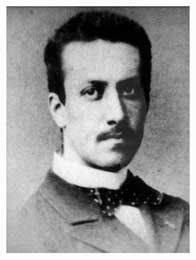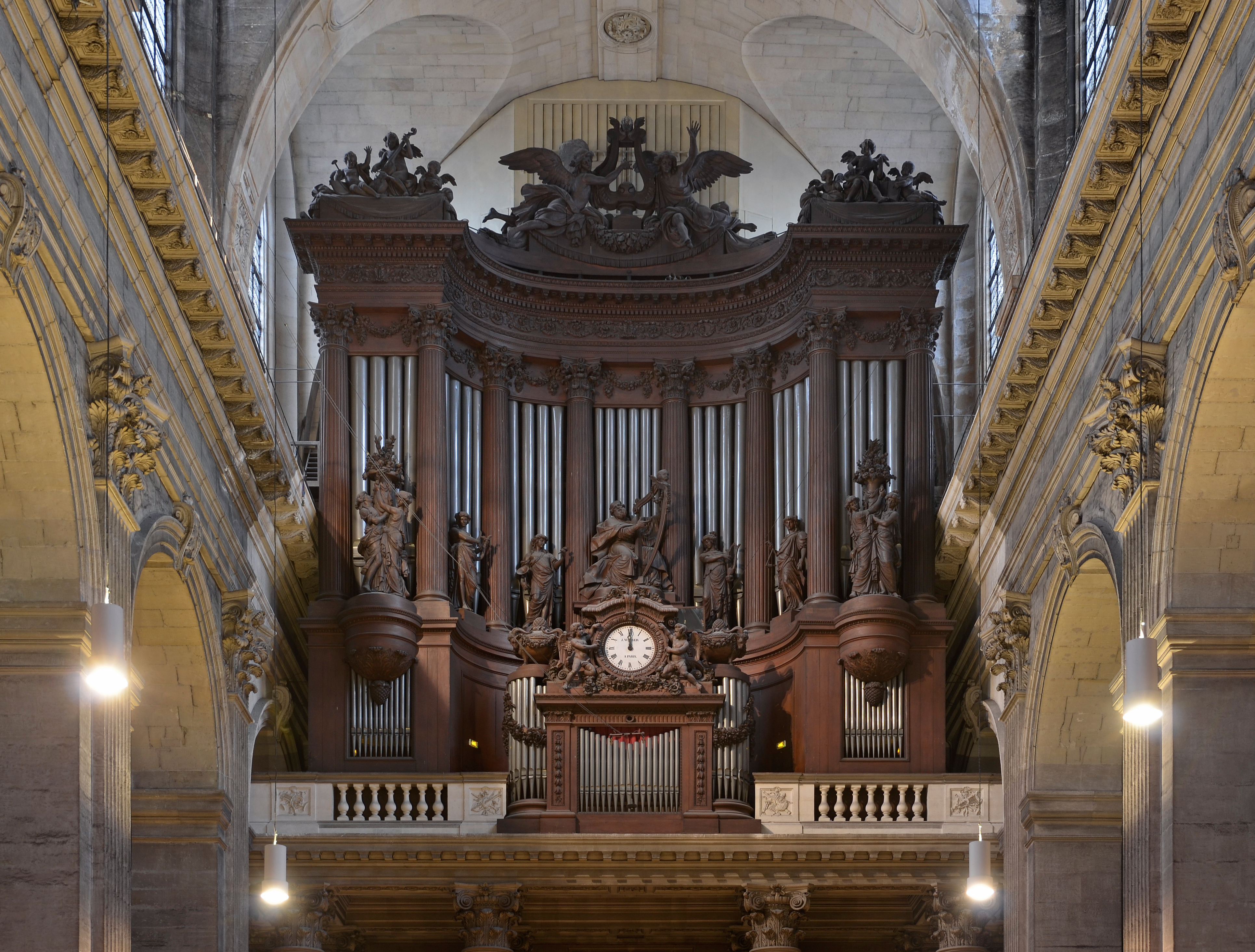|
Widor
Charles-Marie-Jean-Albert Widor (21 February 1844 – 12 March 1937) was a French organist, composer and teacher of the mid-Romantic era, most notable for his ten organ symphonies. His Toccata from the fifth organ symphony has become one of the best known and most often performed works for organ. As of 2022, he is the longest-serving organist of Saint-Sulpice in Paris, a role he held for 63 years (January 1870 – 31 December 1933). He also was organ professor at the Paris Conservatory from 1890 to 1896 (following César Franck) and then he became professor of composition at the same institution, following Théodore Dubois. Widor was a prolific composer, writing music for organ, piano, voice and ensembles. Apart from his ten organ symphonies, he also wrote three symphonies for orchestra and organ, several songs for piano and voice, four operas and a ballet. He was one of the first composers to use the term "symphony" for some of his organ compositions, helped in this by the or ... [...More Info...] [...Related Items...] OR: [Wikipedia] [Google] [Baidu] |
Widor
Charles-Marie-Jean-Albert Widor (21 February 1844 – 12 March 1937) was a French organist, composer and teacher of the mid-Romantic era, most notable for his ten organ symphonies. His Toccata from the fifth organ symphony has become one of the best known and most often performed works for organ. As of 2022, he is the longest-serving organist of Saint-Sulpice in Paris, a role he held for 63 years (January 1870 – 31 December 1933). He also was organ professor at the Paris Conservatory from 1890 to 1896 (following César Franck) and then he became professor of composition at the same institution, following Théodore Dubois. Widor was a prolific composer, writing music for organ, piano, voice and ensembles. Apart from his ten organ symphonies, he also wrote three symphonies for orchestra and organ, several songs for piano and voice, four operas and a ballet. He was one of the first composers to use the term "symphony" for some of his organ compositions, helped in this by the or ... [...More Info...] [...Related Items...] OR: [Wikipedia] [Google] [Baidu] |
Marcel Dupré
Marcel Jean-Jules Dupré () (3 May 1886 – 30 May 1971) was a French organist, composer, and pedagogue. Biography Born in Rouen into a wealthy musical family, Marcel Dupré was a child prodigy. His father Aimable Albert Dupré was titular organist of Saint-Ouen Abbey from 1911 til his death and a friend of Aristide Cavaillé-Coll, who built an organ in the family house when Marcel was 10 years old. His mother Marie-Alice Dupré-Chauvière was a cellist who also gave music lessons, and his paternal uncle Henri Auguste Dupré was a violinist and violist. Both of his grandfathers, Étienne-Pierre Chauvière (maître de chapelle at Saint-Patrice in Rouen and an operatic bass) and Aimable Auguste-Pompée Dupré (who was also a friend of Cavaillé-Coll) were also organists. Having already taken lessons from Alexandre Guilmant (due to him appealing to his father), he entered the Paris Conservatoire in 1904, where he studied with Louis Diémer and Lazare Lévy (piano), Guilmant an ... [...More Info...] [...Related Items...] OR: [Wikipedia] [Google] [Baidu] |
Organ Symphonies
An organ symphony is a piece for solo pipe organ in various Movement (music), movements. It is a Symphony, symphonic genre, not so much in musical form (in which it is more similar to the organ sonata or suite (music), suite), but in imitating orchestral tone color, texture, and symphonic process. Though the very first organ symphony was written by German composer Wilhelm Valentin Volckmar in 1867, the genre is mainly associated with French romanticism. César Franck wrote what is considered to be the first French organ symphony in his ''Grande Pièce Symphonique'', and the composers Charles-Marie Widor, who wrote ten organ symphonies, and his pupil Louis Vierne, who wrote six, continued to cultivate the genre. Modern composers such as Jean Guillou have written organ symphonies as well. The genre is considered to have been brought to fruition in the second organ symphony of André Fleury (organist), André Fleury. The term ''organ symphony'' is also used occasionally to refer to ... [...More Info...] [...Related Items...] OR: [Wikipedia] [Google] [Baidu] |
Louis Vierne
Louis Victor Jules Vierne (8 October 1870 – 2 June 1937) was a French organist and composer. As the organist of Notre-Dame de Paris from 1900 until his death, he focused on organ music, including six organ symphonies and a '' Messe solennelle'' for choir and two organs. He toured Europe and the United States as a concert organist. His students included Nadia Boulanger and Maurice Duruflé. Life Louis Vierne was born in Poitiers on 8 October 1870, the son of Henri-Alfred Vierne (1828–1886), a teacher, who became a journalist. He was editor-in-chief of the ''Journal de la Vienne'' in Poitiers, where he met his future wife, Marie-Joséphine Gervaz. The couple had four children. Louis was born nearly blind due to congenital cataracts. His unusual gift for music was discovered early. When he was only two years of age, he heard the piano for the first time: a pianist played him a Schubert lullaby, and after he had finished young Louis promptly began to pick out the notes of the ... [...More Info...] [...Related Items...] OR: [Wikipedia] [Google] [Baidu] |
Saint-Sulpice (Paris)
, image = Paris Saint-Sulpice Fassade 4-5 A.jpg , image_size = , pushpin map = Paris , pushpin label position = , coordinates = , location = Place Saint-Sulpice 6th arrondissement, Paris , country = France , denomination = Roman Catholic , religious institute = Society of the Priests of Saint Sulpice , website = , bull date = , founded date = , founder = , dedication = Sulpitius the Pious , dedicated date = , consecrated date = , relics = , status = Parish church , functional status = Active , heritage designation = , architect = , style = Baroque , years built = , groundbreaking = 1646 , completed date = 1870 , capacity = , length = , width ... [...More Info...] [...Related Items...] OR: [Wikipedia] [Google] [Baidu] |
Pipe Organ
The pipe organ is a musical instrument that produces sound by driving pressurized air (called ''wind'') through the organ pipes selected from a keyboard. Because each pipe produces a single pitch, the pipes are provided in sets called ''ranks'', each of which has a common timbre and volume throughout the keyboard compass. Most organs have many ranks of pipes of differing timbre, pitch, and volume that the player can employ singly or in combination through the use of controls called stops. A pipe organ has one or more keyboards (called '' manuals'') played by the hands, and a pedal clavier played by the feet; each keyboard controls its own division, or group of stops. The keyboard(s), pedalboard, and stops are housed in the organ's ''console''. The organ's continuous supply of wind allows it to sustain notes for as long as the corresponding keys are pressed, unlike the piano and harpsichord whose sound begins to dissipate immediately after a key is depressed. The smallest po ... [...More Info...] [...Related Items...] OR: [Wikipedia] [Google] [Baidu] |
Darius Milhaud
Darius Milhaud (; 4 September 1892 – 22 June 1974) was a French composer, conductor, and teacher. He was a member of Les Six—also known as ''The Group of Six''—and one of the most prolific composers of the 20th century. His compositions are influenced by jazz and Brazilian music and make extensive use of polytonality. Milhaud is considered one of the key modernist composers.Reinhold Brinkmann & Christoph Wolff, ''Driven into Paradise: The Musical Migr ... [...More Info...] [...Related Items...] OR: [Wikipedia] [Google] [Baidu] |
Paris Conservatoire
The Conservatoire de Paris (), also known as the Paris Conservatory, is a college of music and dance founded in 1795. Officially known as the Conservatoire National Supérieur de Musique et de Danse de Paris (CNSMDP), it is situated in the avenue Jean Jaurès in the 19th arrondissement of Paris, France. The Conservatoire offers instruction in music and dance, drawing on the traditions of the 'French School'. Formerly the conservatory also included drama, but in 1946 that division was moved into a separate school, the Conservatoire National Supérieur d'Art Dramatique (CNSAD), for acting, theatre and drama. Today the conservatories operate under the auspices of the Ministry of Culture and Communication and are associate members of PSL University. The CNSMDP is also associated with the Conservatoire National Supérieur de Musique et de Danse de Lyon (CNSMDL). History École Royale de Chant On 3 December 1783 Papillon de la Ferté, ''intendant'' of the Menus-Plaisirs du Roi, pro ... [...More Info...] [...Related Items...] OR: [Wikipedia] [Google] [Baidu] |
Conservatoire De Paris
The Conservatoire de Paris (), also known as the Paris Conservatory, is a college of music and dance founded in 1795. Officially known as the Conservatoire National Supérieur de Musique et de Danse de Paris (CNSMDP), it is situated in the avenue Jean Jaurès in the 19th arrondissement of Paris, France. The Conservatoire offers instruction in music and dance, drawing on the traditions of the 'French School'. Formerly the conservatory also included drama, but in 1946 that division was moved into a separate school, the Conservatoire National Supérieur d'Art Dramatique (CNSAD), for acting, theatre and drama. Today the conservatories operate under the auspices of the Ministry of Culture and Communication and are associate members of PSL University. The CNSMDP is also associated with the Conservatoire National Supérieur de Musique et de Danse de Lyon (CNSMDL). History École Royale de Chant On 3 December 1783 Papillon de la Ferté, ''intendant'' of the Menus-Plaisirs du Roi, pro ... [...More Info...] [...Related Items...] OR: [Wikipedia] [Google] [Baidu] |
César Franck
César-Auguste Jean-Guillaume Hubert Franck (; 10 December 1822 – 8 November 1890) was a French Romantic composer, pianist, organist, and music teacher born in modern-day Belgium. He was born in Liège (which at the time of his birth was part of the United Kingdom of the Netherlands). He gave his first concerts there in 1834 and studied privately in Paris from 1835, where his teachers included Anton Reicha. After a brief return to Belgium, and a disastrous reception of an early oratorio ''Ruth'', he moved to Paris, where he married and embarked on a career as teacher and organist. He gained a reputation as a formidable musical improviser, and travelled widely within France to demonstrate new instruments built by Aristide Cavaillé-Coll. In 1858, he became organist at the Basilica of St. Clotilde, Paris, a position he retained for the rest of his life. He became professor at the Paris Conservatoire in 1872; he took French nationality, a requirement of the appointment. Afte ... [...More Info...] [...Related Items...] OR: [Wikipedia] [Google] [Baidu] |
Toccata
Toccata (from Italian ''toccare'', literally, "to touch", with "toccata" being the action of touching) is a virtuoso piece of music typically for a keyboard or plucked string instrument featuring fast-moving, lightly fingered or otherwise virtuosic passages or sections, with or without imitative or fugal interludes, generally emphasizing the dexterity of the performer's fingers. Less frequently, the name is applied to works for multiple instruments (the opening of Claudio Monteverdi's opera ''L'Orfeo'' being a notable example). History Renaissance The form first appeared in the late Renaissance period. It originated in northern Italy. Several publications of the 1590s include toccatas, by composers such as Claudio Merulo, Andrea and Giovanni Gabrieli, Adriano Banchieri, and Luzzasco Luzzaschi. These are keyboard compositions in which one hand, and then the other, performs virtuosic runs and brilliant cascading passages against a chordal accompaniment in the other hand. Among the ... [...More Info...] [...Related Items...] OR: [Wikipedia] [Google] [Baidu] |
Symphony For Organ No
A symphony is an extended musical composition in Western classical music, most often for orchestra. Although the term has had many meanings from its origins in the ancient Greek era, by the late 18th century the word had taken on the meaning common today: a work usually consisting of multiple distinct sections or movements, often four, with the first movement in sonata form. Symphonies are almost always scored for an orchestra consisting of a string section (violin, viola, cello, and double bass), brass, woodwind, and percussion instruments which altogether number about 30 to 100 musicians. Symphonies are notated in a musical score, which contains all the instrument parts. Orchestral musicians play from parts which contain just the notated music for their own instrument. Some symphonies also contain vocal parts (e.g., Beethoven's Ninth Symphony). Etymology and origins The word ''symphony'' is derived from the Greek word (), meaning "agreement or concord of sound", "concert of ... [...More Info...] [...Related Items...] OR: [Wikipedia] [Google] [Baidu] |





